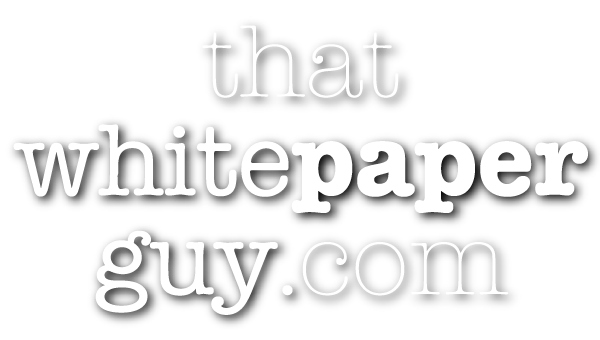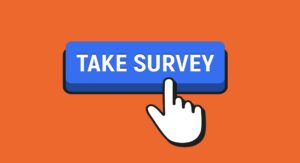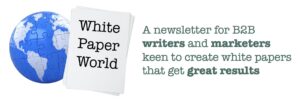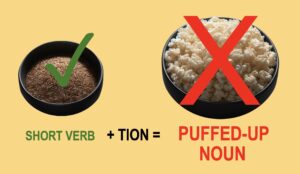White Paper World 27: August 24, 2023
- Quick tip: Build your own list of sources
- This just in: AI is enshittifying the web!
- AI survey book giveaway: Another winner!
- Deadline: Take the AI survey before it closes
- Don’t miss checklist: 12 ways to humanize your content

Quick tip: Build your own list of sources
How to save time researching your next white paper:
Build your own list of sources you trust, and go to them for insights.
I’ve said this before: Don’t start with Google.
Now I’m doubling down on that advice.
Develop your own list of trusted sources. Don’t rely on Google to find them.
This works especially well if you have a clear niche where you already know most of the key players and experts.
And it’s the same process any journalist working a “beat” has always used.
They find a source who makes time for them. Then they call them over and over for quotes and explanations.
Where to find sources?
If you’re an employee or you have a steady client, some of your best sources may be inside the company.

And some may be outside, in places like these:
- Relevant trade associations
- Respected channel partners
- Knowledgable analysts and consultants
- Professors who know the industry
- Authors who’ve written on your topic
- Thoughtful bloggers
To help build your list, follow my tip about using Wikipedia to find primary sources and experts.
Of course, every source must meet all the criteria for timeliness, authority, and relevance. You can see more on my TARP criteria here.
The final factor—proximity—takes care of itself, since all your sources are drawn from the same vertical.
Keep building your list
Always retain your list, and expand it as you go.
Journalists use another trick to do this: They ask each source who else they should speak to.
Your first contact may even e-mail the next to introduce you.
If they don’t, introduce yourself like this, “So-and-so recommended I speak with you…”
Dropping a name means you come in as a warm contact. And that makes your next source more likely to make time for you.
And if you have more than one niche, no problem. Keep a list of sources for each niche.
This just in: AI is enshittifying the web
One of the most articulate voices pointing out the flaws of today’s large language model (LLM) for AI is Gary Marcus.
Marcus is an AI researcher, entrepreneur, and popular author who recently testified to Congress about AI.

Gary Marcus, AI author and researcher who’s critical of LLMs
He warns that today’s AI will have terrible consequences in business, healthcare, law, politics, and even parenting.
“We have built machines that are like bulls in a china shop—powerful, reckless, and difficult to control,” he says. “We should all be deeply worried.”
He notes that we didn’t act fast enough to control social media, and look where we ended up: cyberbullying, data surveillance, fake news, and a whole generation of depressed kids.
His testimony is brief and worth reading, and so is his Substack.
In fact, one of Marcus’ latest posts really struck a chord with me. He called it:
The Imminent Enshittification of the Internet
And here’s his key message: “LLMs are creating a huge sanitation problem that will probably never be solved.”
In other words, as AI makes it faster and cheaper to create fake news and entirely fake websites, the web will get more and more polluted with a rising deluge of crap.
I can’t argue with that.
I believe we’re already seeing this… and that AI adds rocket fuel to the enshittification process already underway.
Here are just two examples. Marcus has lots more.
Exhibit A: Crap sources dredged up by Google
In the old days, I could run a few Google searches and pull up the most definitive sources for any white paper.
Finding the perfect nuggets of research only took a few hours.
![]() Today, any Google search starts with half a page of “sponsored links” aka ads. And much of the rest is skillfully SEO-d clickbait.
Today, any Google search starts with half a page of “sponsored links” aka ads. And much of the rest is skillfully SEO-d clickbait.
I routinely dig through three or four pages of results to find a single source I can use in a white paper. Have you noticed that?
Lots of people have. Here’s one observer who sums it up nicely.
More content. More ads. More SEO. More AI. Add it all up, and we get a rising tide of crap across the web.
Exhibit B: Crappy AI-written books flooding Amazon
Did you ever suspect some items you see on Amazon aren’t “real” books?
In fact, many new e-books are first-draft gibberish spewed out of ChatGPT.

Author Jane Friedman
For example, author Jane Friedman tells how other people are uploading AI-written books with her name as the author: https://janefriedman.com/i-would-rather-see-my-books-pirated/
And she notes how tough it’s been to get Amazon and Goodreads (owned by Amazon) to take those down.
Even though she’s a specialist in the publishing industry with a sizable following. Sigh.
One suggestion: Friedman says Amazon should stop giving out free ISBNs, the unique identifiers for each book in official bibliographic databases.
Right now, AI cheaters can get all the ISBNs they want for free, instead of paying up to $125 each. Those free ISBNs make self-publishing more accessible, but they remove an important gatekeeper and let scammers slip through.
What can we do?
The obvious conclusion is that for years to come, devious people will be using AI to generate me-too content, clickbait, and downright ripoffs.
But if Google and Amazon start serving up this sludge, what will that do to their business?
And what will content writers do when we’re all drowning in sewage?
Marcus says we need legislation and independent third-party reviews of new AIs before they’re released. Something like a new CERN.
Others suggest a new FAA or FDA.
AI legislation brewing in the EU defines various dangers and asks all companies to list the sources of their training data.
I say bring on the rules! Self-regulation seldom works when billions of dollars are up for grabs.
And if I sound more like an AI Resister than an AI Enthusiast, so be it.
AI survey book giveaway: Another winner!
Anne Coyle is a seasoned content writer originally from Canada who relocated to Hawaii six years ago to reconnect with her maternal roots.
After many years of writing about tech, she moved into writing for non-profits, which she says is “way less money, but way more gratification.”

Anne Coyle, copywriter for non-profits and AI user
Like many subscribers, she says, “I’m really enjoying these newsletters on AI. ” (Thanks to you all for telling me!)
Anne’s score on the AI survey was 60% AI Pragmatist and 40% Enthusiast.
While she gives ChatGPT a “C” on long-form copy like white papers, she rates it “A” on short copy.
“ChatGPT has been spectacular at writing things I’m terrible at, like catchy slogans, mission statements, or taglines,” she says. “I had a tagline for my business card in seconds. It would have taken months for me to develop.”
On top of her writing, Anne now serves as executive director of a multi-faceted non-profit on Kauai Island.
“We do a lot of programs,” she says. “We run a small organic farm, a weekly farmer’s market, youth learning programs, history theater, and musical performances. We rehabilitated a historic lodge in the state park, and we’re restoring a historic building, the oldest on Kauai and the second oldest in the whole state.”
Anne was scratching her head for a way to tie all those projects together. After she fed a lot of input to ChatGPT, the AI came up with this tagline…
Honoring Heritage,
Cultivating Sustainable Economic Resilience,
Nourishing Futures
“Isn’t that amazing? I modified it a bit, but I love how it came up with a farm/food metaphor! I just never would have thought of that!”
Anne notes, “In non-profits, story-telling is more important than ever. AI is not necessarily a great storyteller, so the writer still has to come up with the story.”
Deadline: Take the AI survey before it closes!
If you haven’t yet taken my 2-minute survey on AI, don’t delay. I’ll be shutting it down after Labor Day.
You can still find out whether you’re an AI Enthusiast, AI Resister, or AI Pragmatist.
And I still have books you can win just by doing the survey:
- Hardcover copies of Mike Stelzner’s Writing White Papers
- A signed copy of my White Papers For Dummies
Here’s where to take the AI survey… plus get career advice on how to flourish in the era of AI.
To take the survey, click the graphic or use this link: bit.ly/3Nc7wGX
And don’t delay: Do it today!
Free checklist: 12 ways to humanize your content
In case you missed it, here’s another chance to grab my free checklist and see the 12 things human writers can do that AI can’t… so far.
To me, AI writes like an articulate but pedantic bore: It knows a lot, but it doesn’t know how to convey any of it with any personality.
When I ask the AI to liven things up, to include a joke or a parable, to use active voice, it doesn’t seem to know what I’m talking about.
A good human writer can do many things that AI can’t. At least 12, in fact. 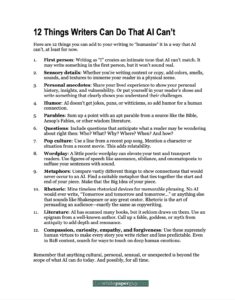
Those things range from setting a scene with sensory details to sharing personal anecdotes to including pop culture references.
And here’s a free checklist to remind you of all 12 of those tactics.
I call this “humanizing” AI text. Otherwise known as revising or editing. I’m ready to do that kind of work. Are you?
So click on the thumbnail or use this link to grab your copy of the checklist:
Checklist–12-Things-Human-Writers-Can-Do-That-AI-Cant
That’s all for this issue
We all know what late August means: back-to-school and back-to-work.
I hope you’re ready. Myself, I’m planning some big changes in the coming year as I step further into semi-retirement.
You can see all the previous issues of White Paper World here:
www.thatwhitepaperguy.com/newsletters/
And to see every future issue, make sure to subscribe here:
www.thatwhitepaperguy.com/subscribe/

Gordon Graham
That White Paper Guy
P.S. Remember to take the survey on AI for a chance to win a free book!
